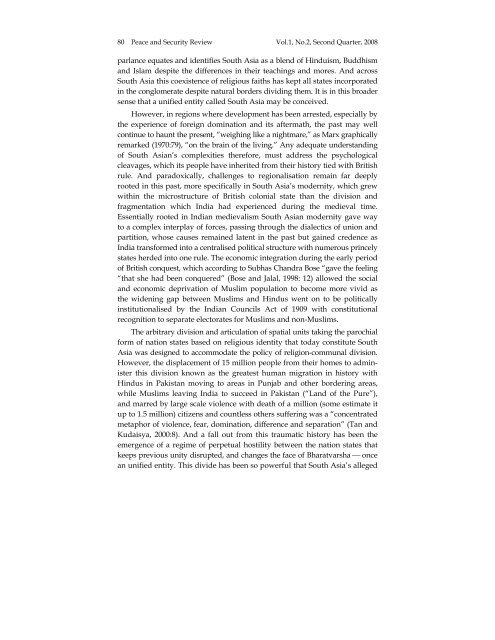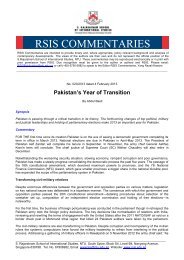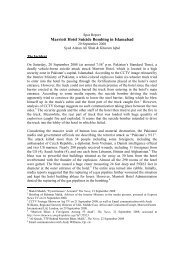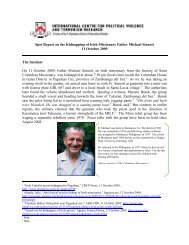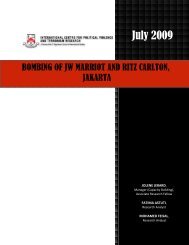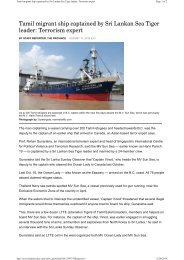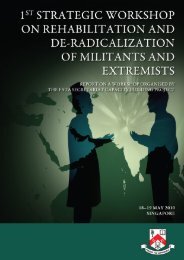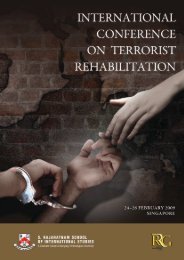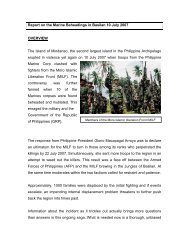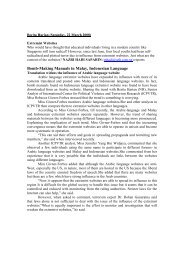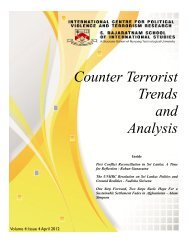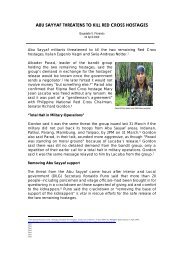Peace and Security Review, Vol.1 No. 2 - International Centre for ...
Peace and Security Review, Vol.1 No. 2 - International Centre for ...
Peace and Security Review, Vol.1 No. 2 - International Centre for ...
Create successful ePaper yourself
Turn your PDF publications into a flip-book with our unique Google optimized e-Paper software.
80 <strong>Peace</strong> <strong>and</strong> <strong>Security</strong> <strong>Review</strong> <strong>Vol.1</strong>, <strong>No</strong>.2, Second Quarter, 2008<br />
parlance equates <strong>and</strong> identifies South Asia as a blend of Hinduism, Buddhism<br />
<strong>and</strong> Islam despite the differences in their teachings <strong>and</strong> mores. And across<br />
South Asia this coexistence of religious faiths has kept all states incorporated<br />
in the conglomerate despite natural borders dividing them. It is in this broader<br />
sense that a unified entity called South Asia may be conceived.<br />
However, in regions where development has been arrested, especially by<br />
the experience of <strong>for</strong>eign domination <strong>and</strong> its aftermath, the past may well<br />
continue to haunt the present, “weighing like a nightmare,” as Marx graphically<br />
remarked (1970:79), “on the brain of the living.” Any adequate underst<strong>and</strong>ing<br />
of South Asian’s complexities there<strong>for</strong>e, must address the psychological<br />
cleavages, which its people have inherited from their history tied with British<br />
rule. And paradoxically, challenges to regionalisation remain far deeply<br />
rooted in this past, more specifically in South Asia’s modernity, which grew<br />
within the microstructure of British colonial state than the division <strong>and</strong><br />
fragmentation which India had experienced during the medieval time.<br />
Essentially rooted in Indian medievalism South Asian modernity gave way<br />
to a complex interplay of <strong>for</strong>ces, passing through the dialectics of union <strong>and</strong><br />
partition, whose causes remained latent in the past but gained credence as<br />
India trans<strong>for</strong>med into a centralised political structure with numerous princely<br />
states herded into one rule. The economic integration during the early period<br />
of British conquest, which according to Subhas Ch<strong>and</strong>ra Bose “gave the feeling<br />
“that she had been conquered” (Bose <strong>and</strong> Jalal, 1998: 12) allowed the social<br />
<strong>and</strong> economic deprivation of Muslim population to become more vivid as<br />
the widening gap between Muslims <strong>and</strong> Hindus went on to be politically<br />
institutionalised by the Indian Councils Act of 1909 with constitutional<br />
recognition to separate electorates <strong>for</strong> Muslims <strong>and</strong> non-Muslims.<br />
The arbitrary division <strong>and</strong> articulation of spatial units taking the parochial<br />
<strong>for</strong>m of nation states based on religious identity that today constitute South<br />
Asia was designed to accommodate the policy of religion-communal division.<br />
However, the displacement of 15 million people from their homes to administer<br />
this division known as the greatest human migration in history with<br />
Hindus in Pakistan moving to areas in Punjab <strong>and</strong> other bordering areas,<br />
while Muslims leaving India to succeed in Pakistan (“L<strong>and</strong> of the Pure”),<br />
<strong>and</strong> marred by large scale violence with death of a million (some estimate it<br />
up to 1.5 million) citizens <strong>and</strong> countless others suffering was a “concentrated<br />
metaphor of violence, fear, domination, difference <strong>and</strong> separation” (Tan <strong>and</strong><br />
Kudaisya, 2000:8). And a fall out from this traumatic history has been the<br />
emergence of a regime of perpetual hostility between the nation states that<br />
keeps previous unity disrupted, <strong>and</strong> changes the face of Bharatvarsha ⎯ once<br />
an unified entity. This divide has been so powerful that South Asia’s alleged<br />
<strong>Vol.1</strong>, <strong>No</strong>.2 2008 pp.77-93


